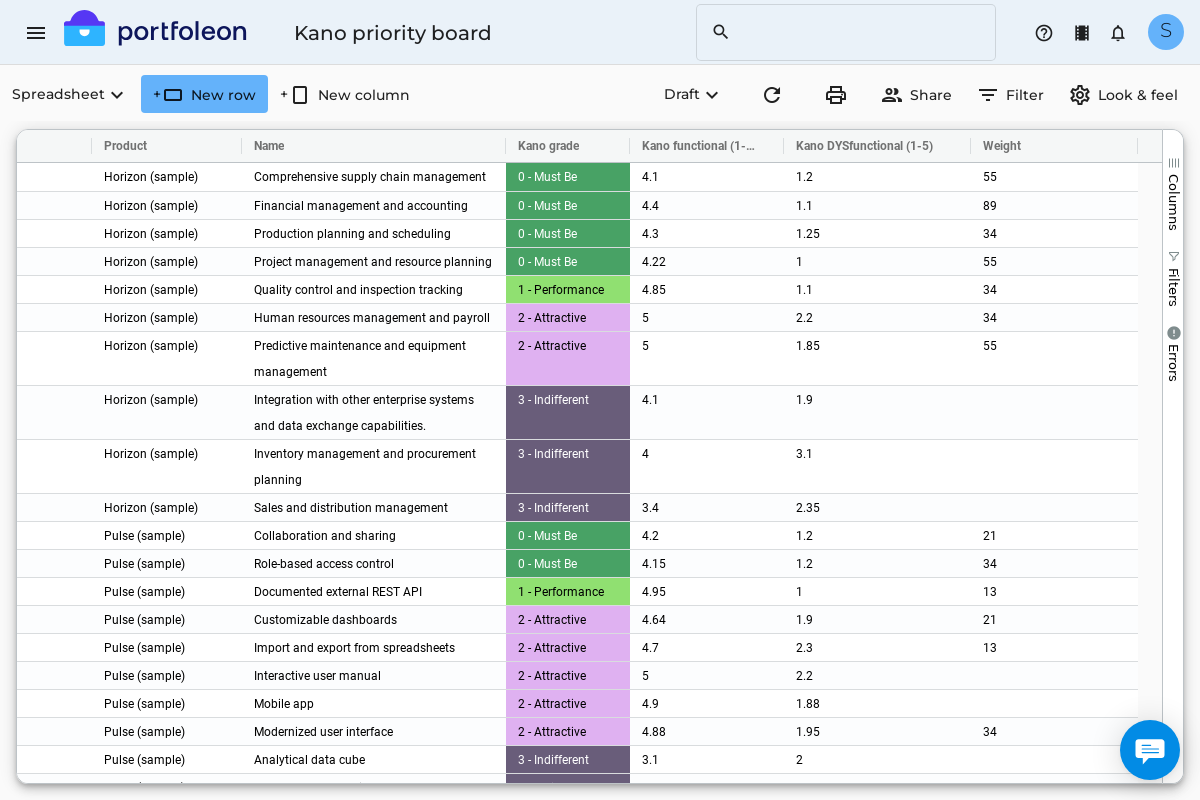A prioritization board helps you visualize the factors that influence the order in which projects get done. You can use it to weigh strategic value, feasibility, stakeholder impact, and more.
In Portfoleon, these boards come in two forms – Kanban or Spreadsheet – depending on how you want to guide the conversation.

Boards are for conversations, not just observation. Portfoleon boards work best when they’re shared – with your team, your peers, your leadership. Use boards in meetings, invite others in.
Strategy isn’t something you “monitor” alone, it’s something you do together.
Prioritization is one of the hardest and most important strategic conversations.
It takes clarity, courage, and sometimes confrontation. Because when you say this is more important than that, not everyone will agree. Some will walk out happy, others frustrated.
Here are a few common pitfalls to watch out for:
⚠️ Common Pitfalls
-
🎯 Personal impact bias
When you say, “Improving quote automation takes priority over warehouse reporting,” Dan (the head of Ops) might hear, “You’re less important than Clare (Sales).”
Even good prioritization can feel personal, so be mindful. -
📦 Everything is “High Priority”
Stakeholders may resist deprioritization. A common pattern is lumping everything into broad buckets: High, Medium, Low.
That’s a fine place to start – but if you stop there, everything becomes High, and nothing is truly prioritized. -
⚙️ Mechanical scoring
Tools like Kano or weighted scoring can help. But if you rely on them too much, the system starts making the decisions instead of people.
Use them as guides but let people make decisions. -
↔️ “Parallel work” as avoidance
Sometimes it makes sense to run projects in parallel. But often it’s just a way to avoid hard calls.
Saying “we’ll do both with equal priority” can feel easier, but it stands in the way of delivering value.Example:
- Sequential: Project A (5 months) → Project B (5 months) = 5-month first delivery
- Parallel: Both in parallel (10 months each) = 10-month first delivery
Prioritizing is hard, but necessary.
Here are some questions to guide impactful discussions:
- What factors influence our priorities?
- 🚩 Which initiatives drive the most impact, and why?
- Is this new request important enough to shift the current priorities?
🚩 Example Difficult Conversation: A New Project Arrives – What Gets Pushed?
You’re an engineering manager. A new project just landed in your lap. It sounds important, but you already have a full plate.
Here’s how you might approach the situation:
🧰 Prepare:
- Define your strategic plan
- Create a prioritization board that shows all relevant prioritization factors
- Do a quick feasibility check using timeline views or pivot tables
🗣 In the conversation:
- Discuss the importance of the new initiative
- Agree (or disagree) on its priority – and reflect that decision in Portfoleon
✅ After the conversation:
- If needed, define alternative implementation paths – e.g., faster vs. cheaper
- Set up a short follow-up to decide which path to pursue
🛠 How to Build This Board
Add fields for factors that influence your priority decision. Portfoleon standard examples include automated scoring rules too, if it’s helpful for your case.
Add a number field for the project’s stack rank. In the boards Look & Feel settings set Row ordering to that new field. You will use this field to prioritize manually.
Define your strategic plan and display the Value field on your prioritization board.
Now you are ready to go. During the conversation, feel free to drag the spreadsheet rows up and down to reflect priority. Portfoleon updates the fields automatically – and stores the changes as a draft, so nothing is final until you’re ready.
💡 Tips to Make It Even Better
-
Use other boards to check feasibility
Complement your prioritization board with timeline or pivot views. These help you see when and how work can actually be done. -
Use color to signal meaning
Apply colors based on department, urgency, initiative type, or risk, to help the board speak for itself.